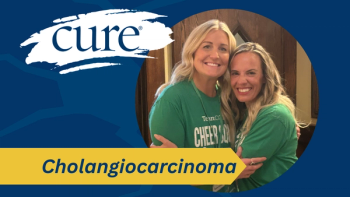
- Winter 2018
- Volume 17
- Issue 1
Cancer Under Cover
Key Takeaways
- Cancer of unknown primary (CUP) presents diagnostic challenges due to the inability to identify the primary cancer site, complicating treatment decisions.
- Gene expression profiling (GEP) and next-generation sequencing (NGS) offer potential for identifying primary sites or actionable mutations, but face cost and insurance coverage challenges.
Two schools of thought exist about how to treat metastatic cancers of unidentified subtype, called carcinomas of unknown primary.
Martin White - PHOTO BY PAUL HAWKETT
Martin White, a 45-year-old consultant safety engineer from East Yorkshire, England, found himself on a rollercoaster without a name starting in January 2015. Pain on his lower left side sent him to the emergency room, but an X-ray and colonoscopy showed nothing abnormal, and he went home. Then the pain returned a month later, and while X-rays suggested impacted bowels, a physical exam and blood tests came back normal. He went home again with no idea what was wrong.
Then, things got scary. A surgical consultant, concerned about White’s X-rays, called him in a few weeks later. What White expected to be a quick visit led to a CT scan revealing enlarged abdominal lymph nodes. An ultrasound then found a mass in his left testicle. The likely diagnosis: testicular cancer, requiring surgical removal of the testicle. But when the pathology report came back, the urologist was befuddled: There was no cancer in the testicle.
“He was unable to explain for sure what the mass had been. They only knew it had not contained cancer cells,” White says. “If we thought we had boarded a rollercoaster before, now it was about to get a lot worse.”
What White had was cancer of unknown primary (CUP), a diagnosis making up 2 to 5 percent of all cancers, or a little over 30,000 cases, in the U.S. That meant that White appeared to have cancer (found in his enlarged lymph nodes, he believes), but doctors could not determine its primary site, the tissue where it had started.
A cancer’s primary site determines its type: Breast cancer starts in the breast and lung cancer starts in the lung, no matter where the disease later spreads. But sometimes cancer metastasizes (spreads to other parts of the body), even if the original tumor doesn’t grow — or regresses before it’s found. “The primary site where it’s coming from is too small most of the time or, for reasons we don’t understand, has spontaneously resolved, which is very rare,” says F. Anthony Greco, M.D., medical director for The Sarah Cannon Cancer Center at Centennial Medical Center in Nashville, Tennessee, and an oncologist at Tennessee Oncology.
Researchers also don’t yet understand how or why such a small undetectable primary cancer spreads elsewhere and then grows large enough to produce symptoms while the cancer at the original site does not enlarge or become clinically evident.
“It’s probably a combination of genetic and epigenetic factors (changes in the way genetic messages are expressed) that allow cancer to spread but not to grow where it started,” Greco says.
Because it can occur anywhere in the body and be any kind of cancer, it’s not even possible to list common symptoms of CUP, since these arise based on where the disease has spread. However, autopsies have shown that a primary cancer is likely present in a patient with CUP, Greco says.
Whatever the reasons it happens, CUP presents a major challenge. Because every cancer requires a treatment regimen specific to its type, doctors don’t know how to begin treating a patient — or even what tests to do — if they don’t know what kind of cancer is present. So, identifying the primary becomes the main goal.
Over the next three months, White had test after test after test: a camera scope down his throat to see his stomach, two unsuccessful attempts to get a fine-needle biopsy of the lymph nodes, a PET scan, MRI scans, spinal fluid sampling, a biopsy of his pelvis bone…
“At this stage, a pattern had emerged,” White says. “We would be seen by a different doctor who would say, ‘We think it’s probably X,’ whatever X was, only for the tests to prove it wasn’t X. Ad infinitum, it seemed.”
All of these tests yielded nothing, but White lost precious time waiting for results.
“I had been diagnosed with cancer in February and, despite seemingly going downhill fast, by May, I had received no treatment at all,” White says. “Even though we understood the reasons, it was hard to take.”
White’s frustrating experience is common for those with CUP.
“Pathology is crucial to guide additional testing,” explains Gauri Varadhachary, M.D., professor of gastrointestinal (GI) medical oncology and medical director of the GI Center at The University of Texas MD Anderson Cancer Center in Houston. Without a focused approach, providers end up doing expensive and time-consuming tests to search for the primary cancer without improving the patient’s care. Where do doctors start?
TWO PATHS FORWARD
White was told he had a 15 percent chance of surviving the year when he finally landed at a top-notch hospital in Leeds. Those oncologists decided they had to do something despite not knowing the primary. Working off a likely diagnosis of testicular cancer, White underwent three cycles of chemotherapy with bleomycin, etoposide and cisplatin, typically used for that type of malignancy.
But cancer therapy research has advanced so quickly that patients with CUP now also have nonchemotherapy treatment options. Using sophisticated diagnostic tests based on tumor-specific proteins and genetic alterations, sometimes doctors can determine where in the body a CUP started and treat the cancer accordingly. Also, there are now several immunotherapies and targeted drugs that can work across cancer types, as long as a tumor expresses certain mutations.
“Five years ago, the research was concentrating only on tissue of origin,” Varadhachary says. “Now it’s not only looking at tissue of origin, but also actionable mutations (those that are treatable with existing drugs).”
Doctors disagree on which path is best for patients with CUP. Greco, a giant in the field who pioneered much of the CUP research that informs experts today, remains steadfastly devoted to finding the primary. This path removes the uncertainty of a CUP diagnosis and allows therapy to begin based on the cancer type. According to Greco’s and others’ research, using both immunohistochemistry (an examination of the proteins in tissue) and gene expression profiling (GEP) — also called a molecular cancer classifier assay — may identify the primary in up to 95 percent of cases.
GEP looks at the way genes express themselves in a biopsied cancerous tissue sample to determine the likely source of the cells. The assay works by determining which genes are turned on and which are turned off, which gives doctors a good idea of where the cells came from. GEP only requires about 300 cells to get a profile that’s then compared to a database of several thousand tumor samples. The results state the likelihood of the cancer’s origin as a percentage. For example, results might show a 96 percent probability that a tumor is colon cancer, which could allow doctors to start treatments specific to that type of disease.
“You’re talking about more than 30 different types of cancer,” says Greco, who is a speaker for Biotheranostics, the company that makes CancerTYPE ID, a GEP test. “You just don’t treat them all the same way.”
GEP’s benefits are the few cells needed to test, the time it takes to get results (five to seven days) and its high level of accuracy. Its biggest drawback is cost, which Greco estimates at $4,000 to $8,000, although he notes that health insurers pay lower rates and Medicare and several insurance companies cover the test.
Another concern, Varadhachary says, is that GEP and clinical presentation sometimes don’t match in identifying the likely cancer, potentially creating more confusion.
Still, limited evidence suggests improved outcomes if doctors know the primary — athough survival remains low because of metastasis and the fact that many of these advanced cancers are not effectively treated. “Doctors either don’t accept or don’t understand that the technology is available to determine what kind of cancer they have,” Greco says.
But there’s at least one other reason doctors may not use GEP, says Sandip P. Patel, M.D., deputy director of the San Diego Center for Precision Immunotherapy and assistant professor at UC San Diego Moores Cancer Center, in California. Learning the primary may require more tests to determine the cancer’s subtype and therapy options, using additional time and a dwindling amount of tissue samples, he says. He agrees that knowing the primary can be very helpful to guiding therapy options. He just doesn’t think it’s the only way.
“The old model we used was that ‘histology is destiny,’” Patel says. Knowing a cancer’s origin was essential for effective treatment in an era in which cytotoxic chemotherapy was the only option. “Today, histology contributes to destiny, but it’s not the end-all be-all.”
Given the rapid developments in targeted therapies, Patel sees promise in looking for genetic abnormalities that might exist across different cancers — which a single therapy might target. NTRK fusion gene mutations, for example, are the “first genomic target” found across many tissues, including some CUP cases, he says, and he expects that researchers will find others. It’s happening in the immunotherapy arena, too, with two drugs recently approved to treat any cancers, regardless of type, that have a mutation status known as microsatellite instability- high. Patel is currently leading a National Cancer Institute study (DART) that is testing Opdivo (nivolumab), one of those drugs, and another immunotherapy, Yervoy (ipilimumab), in various rare tumors, including CUP. Treating this way is increasingly relying on next generation sequencing (NGS), which looks at DNA in a tumor or blood and identifies any genetic mutations — unlike GEP, which reveals the way genes express themselves.
Ideally, if there were no limitations on available money or tissue, Patel says, a doctor would do both GEP and NGS. Unfortunately, he says, insurance often does not cover NGS for patients with CUP, so there may be an out-of-pocket cost for patients. But companies usually cap that amount: for example, at $500.
In a patient who has exhausted his or her options but has only enough tissue for one test, Patel would discuss options but lean toward “the more treatment-oriented procedure” of looking for potentially treatable mutations. He hopes the DART trial will identify more mutations against which immunotherapy may work regardless of the primary cancer type.
The drawback with NGS is that not every cancer necessarily has mutations that can be targeted with current drugs. Varadhachary, with her colleagues, has an ongoing study looking at what percentage of patients with CUP have actionable mutations, which of them will receive a mutation-matched drug on and off trial, and the impact of that on CUP and life expectancy.
“Research in CUP is harder than in other cancer types because it doesn’t fit into any basket,” Patel says. “Common tumor types are in a clean bucket, and you can subdivide them even more cleanly. CUP is a constellation of cancer types from various different organs with varying biology that we don’t understand, grouped together because we can’t find them on imaging or by pathology.”
Very, very few trials exist for patients with CUP alone, since studies tend to be grouped according to cancer type — breast, colon, etc. — or by specific mutations that can be targeted.
“A lot of these patients cannot get onto immunotherapy trials, yet some of these immunotherapies are the best shots on a goal we’ve ever had,” Patel says. Spending time looking for the primary might mean a patient misses the chance to enroll in a trial of a therapy that targets a mutation they don’t know their cancer has, he says.
Greco thinks that’s the wrong approach given GEP’s accuracy, but he sees value in NGS, particularly for some patients with CUP whose specific cancer type is finally diagnosed, or after exhausting all reasonable attempts to determine the cancer type, or if the patient isn’t responding to site-specific treatment and could have targetable mutations.
UNDERSTANDING THE CHALLENGES OF CUP
CUP’s uncertainties can mean a higher need for health care providers to provide education and public awareness, more anxiety on the part of the patient and less time for actual treatment, Varadhachary says.
“It requires a lot on the part of health care providers, to educate and comfort the patient that there will be a treatment plan that will be personalized to work for them,” she says. “The anxiety, the second guessing and the doctor shopping that goes with CUP do not allow the patient to take therapy in an optimal period of time.”
White’s experience was similar, as he was referred from doctor to doctor, except that, so far, he has been part of the 15 percent survival chance he was quoted. White’s chemotherapy regimen, which led to several fevers requiring hospitalization in case of sepsis, ended in July 2015. Soon after, he learned his lymph nodes had shrunk, although not as much as doctors would have liked. A follow-up scan in October 2017 showed the shrinkage had stalled. Fearing recurrence, White opted for a retroperitoneal lymph node dissection (RPLND), a standard treatment option for testicular cancer.
Again, however, the removed tissue had no live cancer cells. Though the surgery may not have been necessary, White says it relieved his fear of recurrence nonetheless. Still, doctors never definitively determined a primary cancer site. The only working theory White’s doctors gave him was that cancer started in his testicle and then spread to his lymph nodes.
“By the time it was discovered, the body had isolated and killed the tumor in the testicle, leaving a burned-out mass behind,” White says. “Whether there was any live cancer in the lymph nodes by the time I had the chemo, we will never know.”
Today, White has no evidence of disease and undergoes blood tests and alternating CT scans and chest X-rays every three months, which will change to every six months this year.
“I had no idea each cancer was different and that there were different treatments for each type,” White says. He now tries to see the experience as a blessing. “The whole process of me possibly going to die has allowed me to heal a couple of family rifts,” he says, “and I’m grateful for that.
Articles in this issue
almost 8 years ago
Jill Biden Shares Her Story During Speech Honoring MPN Patient Advocatesalmost 8 years ago
Stars Shine at Multiple Myeloma Fundraiseralmost 8 years ago
Exploring the Mind-Body Connection in Improving Patient Quality of Lifealmost 8 years ago
Trials and Tribulations: Navigating the Clinical Trial Spacealmost 8 years ago
Funny Business in Cancer Carealmost 8 years ago
Mind, Body and Spirit: How Mindfulness Can Helpalmost 8 years ago
'A Joyful Path Forward' Finding Beauty Close to Homealmost 8 years ago
Let's Get Physical




